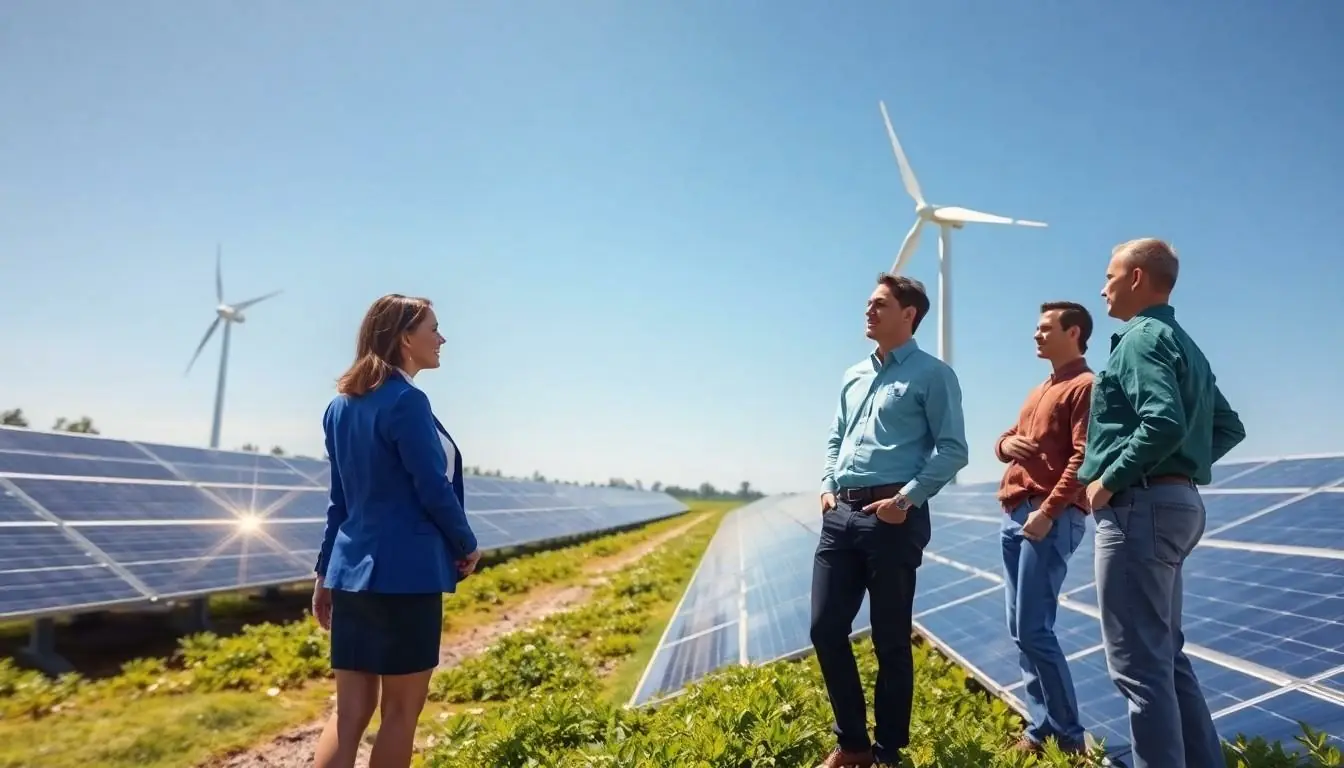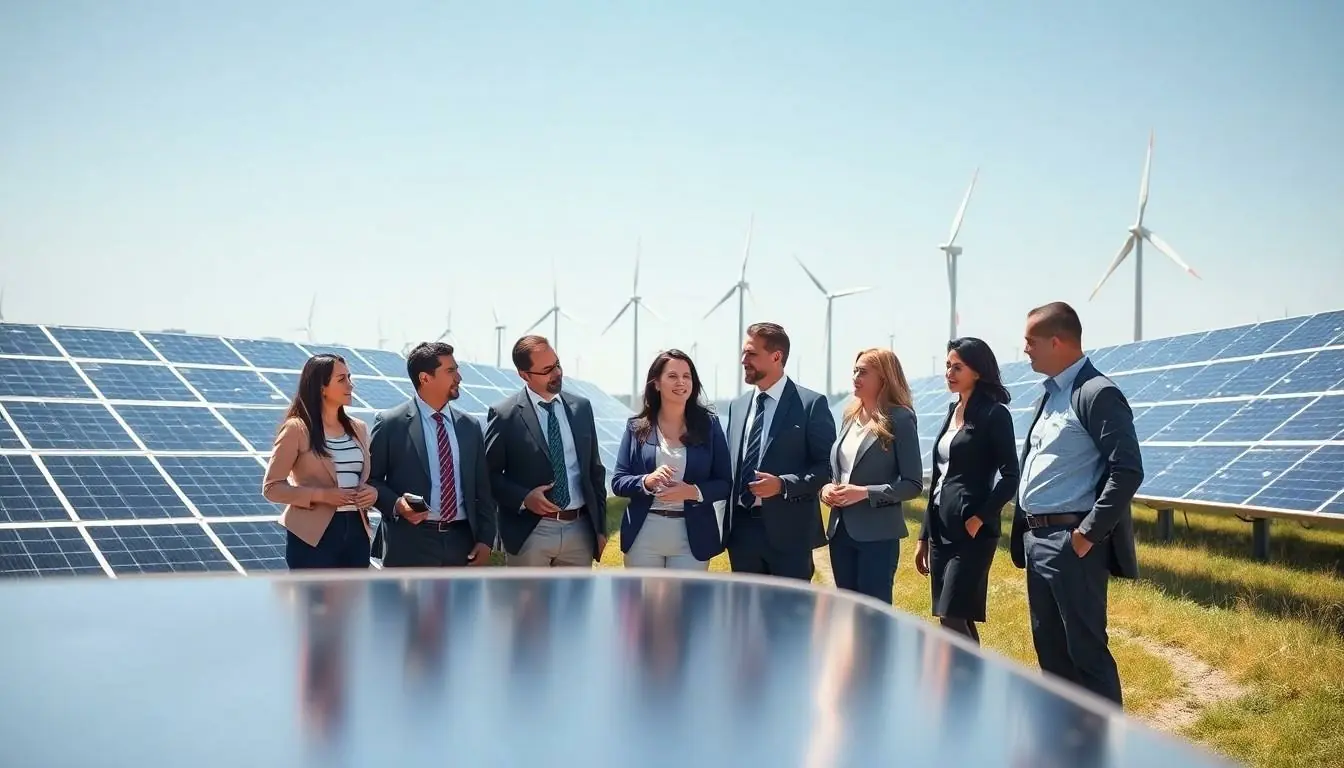In a world where energy bills can feel like a second mortgage, commercial renewable energy is the superhero businesses didn’t know they needed. Gone are the days of relying solely on fossil fuels, which are about as reliable as a cat on a leash. With solar, wind, and other renewable sources stepping into the spotlight, companies can not only save money but also boost their green credentials faster than you can say “eco-friendly.”
Imagine a future where businesses thrive on clean energy, making Mother Nature proud while keeping their wallets happy. It’s not just a dream; it’s happening now. As companies embrace renewable energy, they’re not just reducing their carbon footprint; they’re also tapping into a growing market of conscientious consumers. So, buckle up and get ready to explore how commercial renewable energy can transform not just the planet but also the bottom line.
Table of Contents
ToggleOverview of Commercial Renewable Energy
Commercial renewable energy refers to the use of sustainable energy sources by businesses. This sector primarily focuses on harnessing solar, wind, geothermal, and biomass energy. Companies increasingly adopt these technologies to align with environmental goals and reduce operational costs.
Solar energy systems, including photovoltaic panels, convert sunlight directly into electricity. These systems can be installed on rooftops or in larger solar farms, providing businesses with significant energy savings. Wind energy, generated through turbines, offers another viable option, particularly in regions with consistent wind patterns. Large-scale wind farms contribute to a cleaner energy grid while providing jobs in construction and maintenance.
Geothermal energy relies on heat from below the Earth’s surface. It presents a sustainable solution for heating and cooling needs in commercial buildings. Businesses leveraging geothermal systems enjoy reduced energy expenses over time. Biomass energy, derived from organic materials, offers a way to convert waste into usable power. Companies participating in biomass projects can realize both cost savings and a reduction in landfill waste.
Transitioning to commercial renewable energy not only benefits individual companies financially but also supports broader ecological goals. A clear trend showcases businesses adopting renewable solutions are improving their public image. Environmentally conscious consumers often prefer brands committed to sustainability, enhancing customer loyalty. Financial incentives, like tax credits and grants, further encourage businesses to invest in renewable energy.
As businesses seek to thrive in an eco-friendly market, the integration of renewable energy resources promises significant advantages. The adoption of these technologies represents a major shift towards sustainability in the commercial sector, aligning economic benefits with environmental responsibility.
Types of Commercial Renewable Energy

Commercial renewable energy encompasses various sources, each contributing to sustainability and cost efficiency for businesses. Notable forms include solar, wind, and biomass energy.
Solar Energy
Solar energy utilizes photovoltaic panels to convert sunlight into electricity. Businesses can install these systems on rooftops or within solar farms to maximize energy production. Solar energy significantly lowers utility bills while contributing to a greener environment. Companies often enjoy tax incentives and grants for solar investments, enhancing their financial returns. In sunny regions, solar energy becomes an especially attractive option, providing reliable, clean power.
Wind Energy
Wind energy harnesses natural wind currents through turbines. Turbines, particularly effective in areas with consistent winds, generate substantial electricity contributions. Investing in wind energy decreases reliance on fossil fuels, thus promoting a cleaner energy grid. Many regions incentivize wind energy projects, allowing businesses to capitalize on favorable conditions. Additionally, developing wind farms creates jobs, stimulating local economies while supporting sustainable practices.
Biomass Energy
Biomass energy converts organic waste into usable power. Companies can reduce landfill waste by repurposing materials like wood scraps and agricultural residue. This energy source provides a reliable and renewable option for businesses aiming to lower carbon footprints. Utilizing biomass helps firms diversify their energy portfolios while enhancing sustainability efforts. Furthermore, biomass energy aligns with eco-friendly branding, appealing to consumers who prioritize environmentally conscious choices.
Benefits of Commercial Renewable Energy
Commercial renewable energy offers various advantages that benefit businesses and the environment simultaneously.
Environmental Impact
Renewable energy significantly reduces greenhouse gas emissions. Solar panels and wind turbines produce clean electricity without harmful byproducts. Companies embracing these technologies contribute to cleaner air and water. Additionally, energy sources like biomass convert waste into power, minimizing landfill contributions. Businesses also cultivate positive public perception by prioritizing sustainability. Consumers increasingly favor brands that demonstrate environmental responsibility. This shift not only helps the planet but attracts a growing market of eco-conscious customers.
Economic Advantages
Cost savings represent a major economic benefit of renewable energy adoption. Businesses often experience lower utility bills after installing solar panels or wind turbines. Tax incentives and grants further enhance financial returns, making the shift more attractive. Moreover, companies can hedge against fluctuating fossil fuel prices by investing in renewable sources. Long-term contracts for renewable energy can stabilize expenses and improve budget predictability. Job creation emerges as another economic advantage; the renewable energy sector continues to expand, providing local employment opportunities.
Energy Independence
Energy independence becomes attainable through commercial renewable energy initiatives. Businesses that invest in on-site generation, such as solar rooftop systems, reduce reliance on external energy sources. This autonomy protects against price volatility associated with fossil fuels. Companies contribute to national energy security by decreasing demand for traditional energy sources. Furthermore, diversifying energy portfolios with renewables enables firms to navigate supply challenges. Embracing renewable technologies empowers businesses to control their energy futures effectively.
Challenges in Commercial Renewable Energy
Commercial renewable energy faces several challenges that hinder its widespread adoption. These obstacles include initial costs, technology limitations, and regulatory hurdles.
Initial Costs
Initial costs for implementing renewable energy systems can be substantial. Businesses often face high expenses associated with purchasing and installing solar panels, wind turbines, or geothermal systems. While long-term savings emerge, the upfront investment can deter some companies. Financing options and tax incentives may alleviate these costs. However, not all businesses have equal access to funding solutions, limiting certain organizations from making this transition.
Technology Limitations
Technology limitations present another challenge in commercial renewable energy. Some renewable energy sources depend on specific geographical conditions, constraining where they can effectively operate. Solar energy requires abundant sunlight, while wind energy thrives in areas with consistent breezes. Additionally, energy storage technologies are still developing, complicating the ability to manage power supply during high demand or low production periods. Companies must remain aware of these constraints to optimize their energy strategies.
Regulatory Hurdles
Regulatory hurdles can complicate renewable energy adoption for businesses. Different jurisdictions maintain diverse regulations and permitting processes, which may delay project initiation. Navigating these requirements often becomes frustrating for companies, particularly smaller organizations lacking legal expertise. Governments may offer incentives for renewable energy but often impose strict conditions on eligibility. By understanding the regulatory landscape, businesses can better strategize their approach to incorporating renewable energy solutions.
Future Trends in Commercial Renewable Energy
Commercial renewable energy continues to evolve rapidly, shaped by innovative technologies and supportive policies. Businesses increasingly recognize the importance of adopting sustainable practices to remain competitive and attract eco-conscious consumers.
Innovations in Technology
Technological advancements significantly enhance the efficiency of renewable energy systems. Solar panels now employ bifacial designs that capture sunlight from both sides, increasing energy output by up to 30%. Wind turbine designs feature larger blades and improved materials, boosting energy capture in low-wind areas. Energy storage solutions, such as lithium-ion batteries, enable businesses to store excess power generated during peak production, ensuring consistent energy availability. Smart grid technologies optimize energy distribution, improving reliability and reducing waste. These innovations make renewable energy more accessible and cost-effective for commercial users.
Policy Developments
Recent policy developments provide a favorable environment for commercial renewable energy adoption. Federal tax incentives offer up to 26% in credits for solar investments, reducing financial burdens for businesses. Many states implement renewable portfolio standards, requiring a percentage of energy to come from renewable sources. These mandates encourage companies to invest in clean energy solutions. Additionally, grants and rebates support businesses seeking renewable energy installations, reducing initial investment costs. Regulatory frameworks are increasingly favorable, facilitating smoother transitions to renewable energy systems across various jurisdictions.
Embracing commercial renewable energy is no longer just an option; it’s a necessity for businesses aiming to thrive in a competitive landscape. By investing in sustainable solutions, companies can significantly cut energy costs while enhancing their public image.
The transition to renewable sources like solar and wind not only supports environmental goals but also fosters economic resilience. As technology advances and policies become more favorable, businesses have the opportunity to lead the charge toward a greener future.
Ultimately, the shift to renewable energy represents a strategic move that aligns profitability with responsibility, paving the way for a more sustainable business model.





